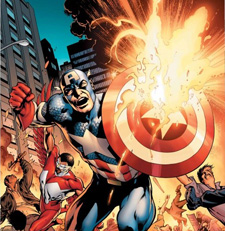Not unexpectedly, there’s a news item about science and Iron Man (it’s getting quite common for the science in movies to be promoted and discussed) just a few weeks before the movie Captain America: Civil War or, as it’s also known, Captain America vs. Iron Man opens in the US. From an April 26, 2016 news item on phys.org,
… how much of our favourite superheros’ power lies in science and how much is complete fiction?
As Iron Man’s name suggests, he wears a suit of “iron” which gives him his abilities—superhuman strength, flight and an arsenal of weapons—and protects him from harm.
In scientific parlance, the Iron man suit is an exoskeleton which is worn outside the body to enhance it.
An April 26, 2016 posting by Chris Marr on the ScienceNetwork Western Australia blog, which originated the news item, provides an interesting overview of exoskeletons and some of the scientific obstacles still to be overcome before they become commonplace,
In the 1960s, the first real powered exoskeleton appeared—a machine integrated with the human frame and movements which provided the wearer with 25 times his natural lifting capacity.
The major drawback then was that the unit itself weighed in at 680kg.
UWA [University of Western Australia] Professor Adrian Keating suggests that some of the technology seen in the latest Marvel blockbuster, such as controlling the exoskeleton with simple thoughts, will be available in the near future by leveraging ongoing advances of multi-disciplinary research teams.
“Dust grain-sized micromachines could be programmed to cooperate to form reconfigurable materials such as the retractable face mask, for example,” Prof Keating says.
However, all of these devices are in need of a power unit small enough to be carried yet providing enough capacity for more than a few minutes of superhuman use, he says.
Does anyone have a spare Arc Reactor?
Currently, most exoskeleton development has been for medical applications, with devices designed to give mobility to amputees and paraplegics, and there are a number in commercial production and use.
Dr Lei Cui, who lectures in Mechatronics at Curtin University, has recently developed both a hand and leg exoskeleton, designed for use by patients who have undergone surgery or have nerve dysfunction, spinal injuries or muscular dysfunction.
“Currently we use an internal battery that lasts about two hours in the glove, which can be programmed for only four different movement patterns,” Dr Cui says.
Dr Cui’s exoskeletons are made from plastic, making them light but offering little protection compared to the titanium exterior of Stark’s favourite suit.
It’s clear that we are a long way from being able to produce a working Iron Man suit at all, let alone one that flies, protects the wearer and has the capacity to fight back.
This is not the first time I’ve featured a science and pop culture story here. You can check out my April 28, 2014 posting for a story about how Captain America’s shield could be a supercapacitor (it also has a link to a North Carolina State University blog featuring science and other comic book heroes) and there is my May 6, 2013 post about Iron Man 3 and a real life injectable nano-network.
As for ScienceNetwork Western Australia, here’s more from their About SWNA page,
ScienceNetwork Western Australia (SNWA) is an online science news service devoted to sharing WA’s achievements in science and technology.
SNWA is produced by Scitech, the state’s science and technology centre and supported by the WA Government’s Office of Science via the Department of the Premier and Cabinet.
Our team of freelance writers work with in-house editors based at Scitech to bring you news from all fields of science, and from the research, government and private industry sectors working throughout the state. Our writers also produce profile stories on scientists. We collaborate with leading WA institutions to bring you Perspectives from prominent WA scientists and opinion leaders.
We also share news of science-related events and information about the greater WA science community including WA’s Chief Scientist, the Premier’s Science Awards, Innovator of the Year Awards and information on regional community science engagement.
Since our commencement in 2003 we have grown to share WA’s stories with local, national and global audiences. Our articles are regularly republished in print and online media in the metropolitan and regional areas.
Bravo to the Western Australia government! I wish there initiatives of this type in Canada, the closest we have is the French language Agence Science-Presse supported by the Province of Québec.
